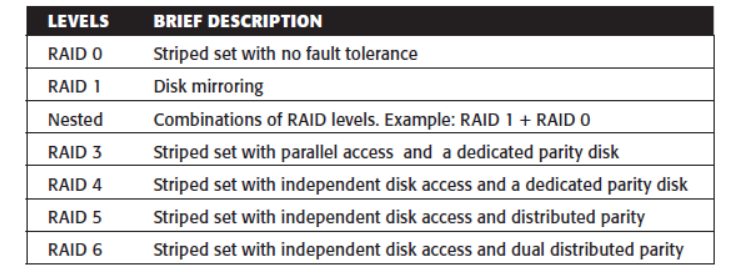Explain levels of Raid with neat diagram?
STORAGE AREA NETWORKExplanation
RAID Levels
➢ RAID Level selection is determined by below factors:
✓ Application performance
✓ data availability requirements
✓ cost
➢ RAID Levels are defined on the basis of:
✓ Striping
✓ Mirroring
✓ Parity techniques
➢ Some RAID levels use a single technique whereas others use a combination of techniques.
➢ Table shows the commonly used RAID levels
1 RAID 0
➢ RAID 0 configuration uses data striping techniques, where data is striped across all the disks
within a RAID set. Therefore it utilizes the full storage capacity of a RAID set.
➢ To read data, all the strips are put back together by the controller.
➢ Fig 1.14 shows RAID 0 in an array in which data is striped across five disks.
➢ When the number of drives in the RAID set increases, performance improves because more
data can be read or written simultaneously.
RAID 1
➢ RAID 1 is based on the mirroring technique.
➢ In this RAID configuration, data is mirrored to provide fault tolerance (see Fig 1.15). A
➢ RAID 1 set consists of two disk drives and every write is written to both disks.
➢ The mirroring is transparent to the host.
➢ During disk failure, the impact on data recovery in RAID 1 is the least among all RAID
implementations. This is because the RAID controller uses the mirror drive for data recovery.
➢ RAID 1 is suitable for applications that require high availability and cost is no constraint.
Nested RAID
➢ Most data centers require data redundancy and performance from their RAID arrays.
➢ RAID 1+0 and RAID 0+1 combine the performance benefits of RAID 0 with the redundancy
benefits of RAID 1.
➢ They use striping and mirroring techniques and combine their benefits.
➢ These types of RAID require an even number of disks, the minimum being four.
RAID 3
➢ RAID 3 stripes data for high performance and uses parity for improved fault tolerance.
➢ Parity information is stored on a dedicated drive so that data can be reconstructed if a drive
fails. For example, of five disks, four are used for data and one is used for parity.
➢ RAID 3 always reads and writes complete stripes of data across all disks, as the drives operate
in parallel. There are no partial writes that update one out of many strips in a stripe.
➢ RAID 3 provides good bandwidth for the transfer of large volumes of data. RAID 3 is used in
applications that involve large sequential data access, such as video streaming.
RAID 4
➢ RAID 4 stripes data for high performance and uses parity for improved fault tolerance. Data
is striped across all disks except the parity disk in the array.
➢ Parity information is stored on a dedicated disk so that the data can be rebuilt if a drive fails.
Striping is done at the block level.
➢ Unlike RAID 3, data disks in RAID 4 can be accessed independently so that specific data
elements can be read or written on single disk without read or write of an entire stripe. RAID
4 provides good read throughput and reasonable write throughput.
RAID 5
➢ RAID 5 is a versatile RAID implementation.
➢ It is similar to RAID 4 because it uses striping. The drives (strips) are also independently
accessible.
➢ The difference between RAID 4 and RAID 5 is the parity location. In RAID 4, parity is
written to a dedicated drive, creating a write bottleneck for the parity disk
➢ In RAID 5, parity is distributed across all disks. The distribution of parity in RAID 5
overcomes the Write bottleneck. Below Figure illustrates the RAID 5 implementation.
➢ Fig 1.18 illustrates the RAID 5 implementation.
➢ RAID 5 is good for random, read-intensive I/O applications and preferred for messaging, data
mining, medium-performance media serving, and relational database management system
(RDBMS) implementations, in which database administrators (DBAs) optimize data access.
RAID 6
➢ RAID 6 includes a second parity element to enable survival in the event of the failure of two
disks in a RAID group. Therefore, a RAID 6 implementation requires at least four disks.
➢ RAID 6 distributes the parity across all the disks. The write penalty in RAID 6 is more than
that in RAID 5; therefore, RAID 5 writes perform better than RAID 6. The rebuild operation
in RAID 6 may take longer than that in RAID 5 due to the presence of two parity sets.
